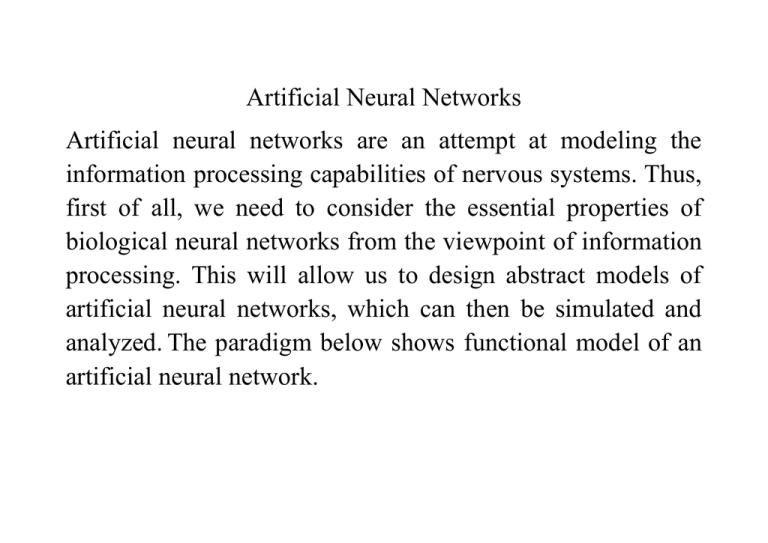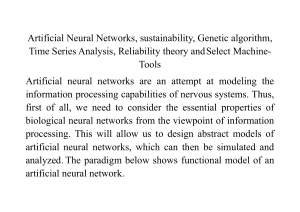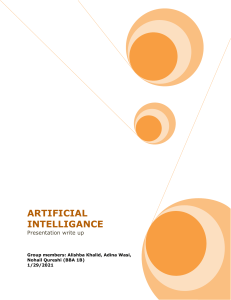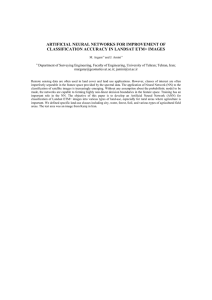Artificial Neural Networks information processing capabilities of nervous systems. Thus,
advertisement

Artificial Neural Networks Artificial neural networks are an attempt at modeling the information processing capabilities of nervous systems. Thus, first of all, we need to consider the essential properties of biological neural networks from the viewpoint of information processing. This will allow us to design abstract models of artificial neural networks, which can then be simulated and analyzed. The paradigm below shows functional model of an artificial neural network. Functional model of an artificial neural network The Taylor series for a function F which is being approximated around the point x0 is; F(x) = a0 + a1(x − x0) + a2(x − x0)2 + ··· + an(x − x0)n + ···, whereby the constants a0, ..., an depend on the function F and its derivatives at x0. What is sustainability? There is no simple definition of 'sustainability'. It can be an idea, a property of living systems, a manufacturing method or a way of life. In fact, there may be as many definitions of sustainability as there are people trying to define it. However, most definitions include: living within the limits of what the environment can provide understanding the many interconnections between economy, society and the environment the equal distribution of resources and opportunities. Sustainability connections Economic Environmental Social Economic development Resource use e.g. water Human and worker rights Local industry Waste generation participation Paying appropriate wages Jobs created Material sourcing Working conditions Corporate governance Atmospheric pollution Freedom of association Public reporting Toxic material disposal Workforce diversity Sustainable development aims to meet human needs in the present while preserving the environment so that these needs can also be met in the indefinite future. OEH implements environmental sustainability programs that include actions to: reduce the use of physical resources including water and energy encourage recycling increase the use of renewable resources encourage redesign of production processes and products to eliminate the production of toxic materials protect and restore natural habitats and environments valued for their biodiversity or beauty. These programs aim to strike the balance between benefits for the environment and society and economic costs - helping to move NSW towards a more sustainable future. Genetic algorithm In the computer science field of artificial intelligence, genetic algorithm (GA) is a search heuristic that mimics the process of natural selection. This heuristic (also sometimes called a metaheuristic) is routinely used to generate useful solutions to optimization and search problems. Genetic algorithms belong to the larger class of evolutionary algorithms (EA), which generate solutions to optimization problems using techniques inspired by natural evolution, such as inheritance, mutation, selection, and crossover. Time Series Analysis Definition A sequence of numerical data points in successive order, usually occurring in uniform intervals. a time series is simply a sequence of numbers collected at regular intervals over a period of time. the aim of this tool is to find out the particular phenomenon. Goals of time series analysis: 1. Descriptive: Identify patterns in correlated data—trends and seasonal variation 2. Explanation: understanding and modeling the data. 3. Forecasting: prediction of short-term trends from previous patterns. 4. Intervention analysis: how does a single event change the time series? 5. Quality control: deviations of a specified size indicate a problem. Mean equation is; where N is the number of observations in the whole series, k is the lag. Y is the mean of the whole series and the denominator is the variance of the whole series. Reliability theory Reliability theory describes the probability of a system completing its expected function during an interval of time. It is the basis of reliability engineering, which is an area of study focused on optimizing the reliability, or probability of successful functioning, of systems, such as airplanes, linear accelerators, and any other product. It developed apart from the mainstream of probability and statistics . Definition of Reliability Reliability is the probability of performing without failure, a specific function under given conditions for a specified period of time. Mathematical definition of reliability Probability distribution function (cdf) of T, Terms reliability R(t), unreliability F(t), time to failure density f(t), failure rate function fr(t), hazard h(t) and cumulative hazard H(t) functions as well as their interrelationships. Other terms relating to mean life are also introduced. FT (t) is usually called the unreliability at time t. It represents the probability of failure in the interval [0, t]. The probability of failure in the interval (t1, t2] equals F(t2) − F(t1). Definition: The reliability function is: Select Machine-Tools The selection of machine-tools is largely a matter of judgment, based on the consideration of many variable factors. No fixed rules can be laid down, but the uses to which the machines are put are divided roughly into three classes which govern to a large extent the types of machine that should be purchased, whether they should be machines of a wide range of usefulness, standardized machines equipped with special tooling or specialpurpose machines of special design capable of very large and continuous production. To determine into which of these classes the requirement for new machines falls, an analysis should be made of the following factors: (a) quantity of production required and its duration, (b) method of machining and tolerances and finish required, (c) possibility of a change in design of the product, (d) cost of production, (e) when delivery of machine is required, and (f) money available for the purchase.






